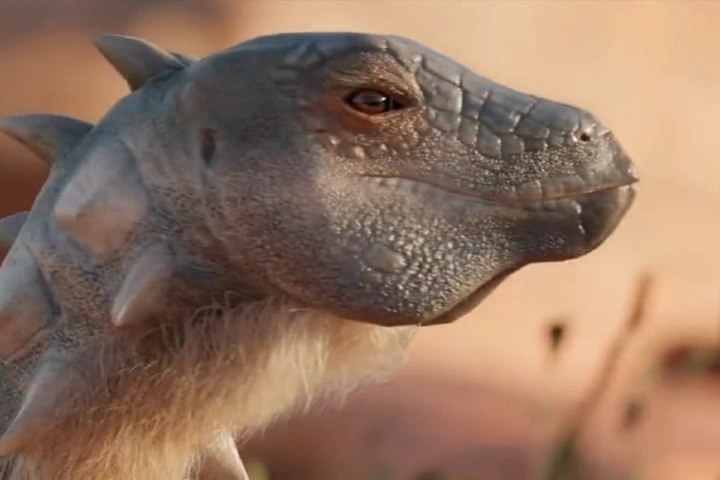

The artistic impression of Jakapil kaniukura (Pic. Courtesy sciencealert.com)
<p>
<strong>A finding that opens up an entirely new window of the past is always welcome and that is what the remains of a small and prickly dinosaur in South America did. This discovery, scientists feel, has unveiled a complete family of dinosaurs who were armoured and interestingly not known at all.</strong></p>
<p>
Uncovered by F&eacute;lix de Azara Natural History Foundation&rsquo;s palaeontologists it is a partial skeleton of a subadult. The scientists of this Foundation in Argentina found the remains in northern Patagonia&rsquo;s R&iacute;o Negro province have christened the newly discovered species as Jakapil kaniukura.</p>
<p>
While its appearance is similar to other armoured dinosaurs like Stegosaurus or Ankylosaurus, it hails from the last era of these creatures, the Cretaceous and roamed the planet between 97 million and 94 million years ago.</p>
<blockquote class="twitter-tweet">
<p dir="ltr" lang="en">
&bull; Jakapil kaniukura &bull;<br />
here is the first thyreophoran from Argentinian Patagonia<br />
Such an honour work with Sebastian Apesteguia, Facundo Riguetti and Mauricio &Aacute;lvarez to achieve this reconstruction.<a href="https://twitter.com/hashtag/blender?src=hash&amp;ref_src=twsrc%5Etfw">#blender</a> <a href="https://twitter.com/hashtag/blendercommunity?src=hash&amp;ref_src=twsrc%5Etfw">#blendercommunity</a> <a href="https://twitter.com/hashtag/paleoart?src=hash&amp;ref_src=twsrc%5Etfw">#paleoart</a> <a href="https://twitter.com/hashtag/paleontology?src=hash&amp;ref_src=twsrc%5Etfw">#paleontology</a> <a href="https://twitter.com/hashtag/Jakapil?src=hash&amp;ref_src=twsrc%5Etfw">#Jakapil</a> <a href="https://twitter.com/hashtag/Argentina?src=hash&amp;ref_src=twsrc%5Etfw">#Argentina</a> <a href="https://t.co/Hf4ZphlWsH">pic.twitter.com/Hf4ZphlWsH</a></p>
&mdash; PaleoGDY (@PaleoGDY) <a href="https://twitter.com/PaleoGDY/status/1557819385946988544?ref_src=twsrc%5Etfw">August 11, 2022</a></blockquote>
<script async src="https://platform.twitter.com/widgets.js" charset="utf-8"></script><p>
This points in a vital direction that there were armoured dinosaurs in the Southern Hemisphere which have not been found so far, remarked palaeontologists in their study.</p>
<p>
This weight of this species was equivalent to that of a house cat and it achieved a length of 5 feet. There was a row of protective spines which started at its neck and ended at its tail. An herbivore, its teeth were leaf-shaped like that of Stegosaurus.</p>
<p>
Walking upright and sporting a beak which was short, this small creature was capable of a strong bite. It was capable of eating hard and woody vegetation.</p>
<p>
Details of this study was published in the journal Scientific Reports.</p>
<p>
Researchers have put this new dinosaur in the group called Thyreophora which has Ankylosaurus, Stegosaurus and others who had armour back.</p>
<p>
Till now a majority of these thyreophorans have been found in the Northern Hemisphere and the earliest members of this family were discovered in rocks found in North America and Europe, that go back to the Jurassic period &ndash; from 201 million years to 163 years ago.</p>
<p>
Sharing their views about this species, the palaeontologists from F&eacute;lix de Azara Natural History Foundation Facundo J. Riguetti and Sebasti&aacute;n Apestegu&iacute;a and from University of Pa&iacute;s Vasco Xabier Pereda-Suberbiola in the paper remarked that this finding <a href="https://www.sciencealert.com/researchers-in-south-america-discover-a-new-species-of-tiny-but-tough-dinosaurs?utm_source=ScienceAlert+-+Daily+Email+Updates&amp;utm_campaign=eb533c219f-RSS_EMAIL_CAMPAIGN&amp;utm_medium=email&amp;utm_term=0_fe5632fb09-eb533c219f-366100389">&quot;shows that early thyreophorans</a> had a much broader geographic distribution than previously thought.&rdquo;</p>
<p>
They went on to add that it was astonishing that the lineage of thyreophorans which goes back to ancient times managed to live into the Late Cretaceous in South America. It was indeed surprising since in the Northern Hemisphere, the older types of thyreophorans seem to have vanished by the Middle Jurassic.</p>
<p>
However, on the southern supercontinent Gondwana, these species did well to live into the Cretaceous period. Thyreophorans which came later like Ankylosaurus lived for a longer period and they were gone from the planet along with other non-avian dinosaurs 66 million years ago.</p>
<p>
The name of this species is derived from two indigenous languages.</p>
<p>
While &quot;Jakapil&quot; in the Puelchean or northern Tehuelchean Indigenous language of Argentina means &ldquo;shield bearer&rdquo;, &ldquo;kanikura&quot; means &quot;crest&quot; and &quot;stone&quot; in the Indigenous Mapudungun language.</p>
In the aftermath of the tragic terror attack that led to the death of many…
India appreciated the Saudi Arabian side for continuing their welfare programmes for almost 3 million…
Kobbi Shoshani, Consul General of Israel to Midwest India, Mumbai on Wednesday condemned the terrorist…
Amjad Ayub Mirza, a political activist from Pakistan-occupied Jammu and Kashmir (PoJK) currently based in…
Following Tuesday's terror attack in Pahalgam that had left Kashmir Valley in deep mourning and…
Prime Minister Narendra Modi's visit to Jeddah saw the signing of several MoUs in various…